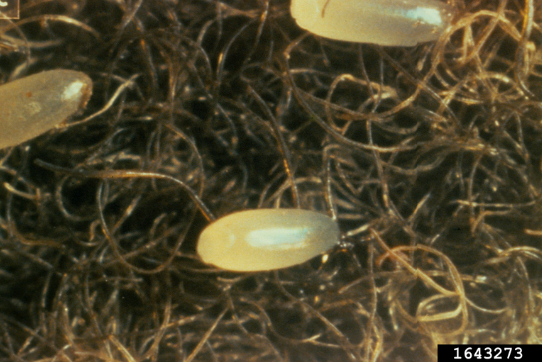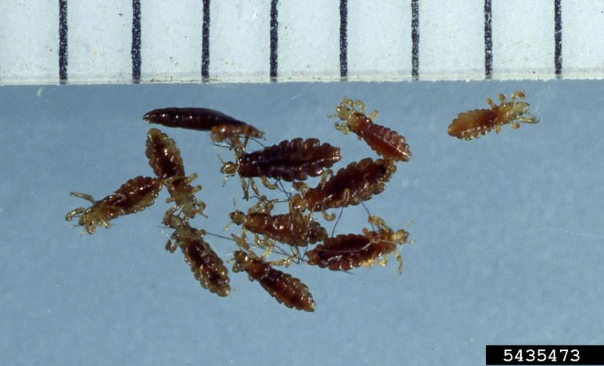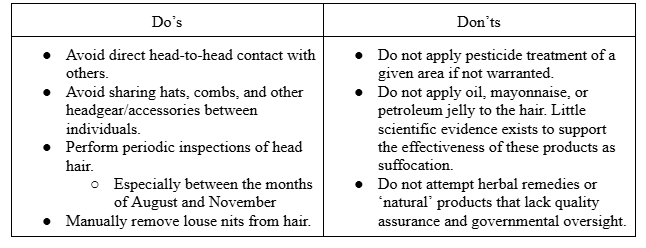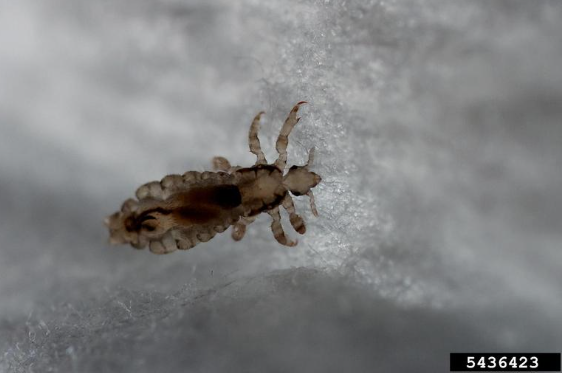Head Lice
ENTFACT-607: Head Lice | Download PDF
by Allison Lopina, Graduate Research Assistant & ZAch DeVries, Extension Specialist
University of Kentucky College of Agriculture
FAST FACTS
- Head lice are insects that most commonly affect young children in school and daycare settings.
- Head lice are found exclusively on humans, specifically on hair shafts of the head and neck.
- While head lice are a nuisance and make your skin itch, their bloodsucking feeding is not known to transmit any diseases.
- Head lice infestations can be taken care of with medicated shampoos, prescriptions from a medical provider, or physical removal of the adults and eggs with a fine-tooth comb.
Dani Barchana, Bugwood.org
Introduction
Head lice are bloodsucking insects that live and feed exclusively on human hosts. The first indication of head lice is scratching and itching, which is caused by the bloodsucking feeding behavior from the louse. This pest can cause great discomfort to individuals. While the head lice feed on human blood, they are not known to spread any diseases. The head lice can only crawl, and they are unable to jump or fly. Anybody can suffer a head lice infestation, and infestations are not indicative of poor personal hygiene.
Lice belong to the order Phthiraptera, which includes both sucking lice (Anoplura) and chewing lice (Mallophaga). Lice are highly host specific, so you will usually only find louse species on single animal species. There are also other types of lice that do infest the body and pubic region, such as human body lice and pubic or crab lice.
Identification
Head lice may be found on any areas where hair is present on the human head. All lice life stages are visible with the naked eye, but can be easier to see with a magnifying glass. Because lice undergo gradual metamorphosis, both immatures and adults look similar to each other. The bodies of these individuals are flattened like a coin (dorsoventrally).
Head lice eggs, also called nits, are very tiny in size, approximately the size of a grain of sand, and can be found attached to hair shafts close to the scalp. The nymphs are similar to the head lice adult form, but much smaller. Immatures will be about the size of a pinhead. The adults will be around ⅛ inch , comparable in size to a sesame seed. The adult head lice has 6 legs with claws and are a tan to grayish-opaque color.

USDA Forest Service - Couer d’Alene Field Office, Bugwood.org
Life Cycle
All head lice life stages are ectoparasitic and remain on their host; the lice obtain nourishment from human hosts while remaining on the outside of the host’s body. Head lice begin as an egg. The nits may mistakenly be identified as dandruff or shampoo residue. The nits are tan and have an oval shape. Once the eggs hatch, they become nymphs. They will become adults 7 days after molting. Adult lice can live up to 30 days on a human host, but must feed on blood several times a day to survive. If adults lack blood meals they will die within 1 to 2 days.

Where Lice Come From
Head lice are typically found on the head, and are commonly a problem amongst young school children. Schools provide the perfect environment for head lice infestations: large numbers of bodies congregated within close, personal contact. These conditions permit easy transfer of head lice between individuals. Transfer can also occur from sharing belongings between infected and uninfected individual.
Head lice are mainly transferred by direct head-to-head contact from an infested person’s head hair. They may also be acquired through the use of shared combs, hats, and hair accessories. They have the ability to remain on bedding and upholstered furniture for a short amount of time as well. However, the probability of transmission through pillowcases and bedding is extremely low. Contact with other objects before coming into contact with the head seems to lower the rate of transmission for head lice.
Prevention & Control Measures
If you are suffering from a head lice infestation, you should seek treatment from a medical professional. Most common treatments may include medicated shampoos or mechanical removal. Mechanical removal will involve using a fine-tooth comb to remove the nits (eggs) from your hair. Physical removal can be quite time consuming and needs to be done thoroughly. Louse shampoo typically does not target nits, so it is important to remove the nits manually. Formulated shampoos are created to control the lice, and most contain a form of pyrethrin or permethrin. Stronger formulations and alternative head lice topical treatments require a prescription, and are typically not recommended for young children. Before using any product, you should ensure that the label specifically states for the use of people. All infected individuals must be treated in order for the condition to completely end.
To prevent the transmission of head lice between individuals, it is important to keep personal belongings separated and not touching. Head-to-head contact should also be avoided between individuals to lower the risk of transferring lice. Sharing of personal belongings (such as hats, coats, brushes) should be minimized or at least examined if you believe the individual has head lice. A good rule of thumb is to avoid contact with individuals who are infested, and to avoid items or areas they may have come into contact with. Animals cannot spread head lice.
As a safety precaution, clothing and items should also be washed and dried after the infestation is cleared up. Washing in hot soapy water (150ºF) and a high heat drying cycle (at least 20 minutes) should be sufficient. It is beneficial to perform regular inspections of children’s hair for head lice.
It is important to note that there are many other causes for an itchy scalp that should be ruled out before concluding it is definitely head lice causing your discomfort. A common factor for similar symptoms include dry air and lack of moisture which can cause irritation and similar effects.
Dealing With Head Lice: Do’s and Don’ts

Issued: 2/93
Revised: 11/24
CAUTION! Pesticide recommendations in this publication are registered for use in Kentucky, USA ONLY! The use of some products may not be legal in your state or country. Please check with your local county agent or regulatory official before using any pesticide mentioned in this publication.
Of course, ALWAYS READ AND FOLLOW LABEL DIRECTIONS FOR SAFE USE OF ANY PESTICIDE!
Photos: Mike Potter, University of Kentucky Entomology.

